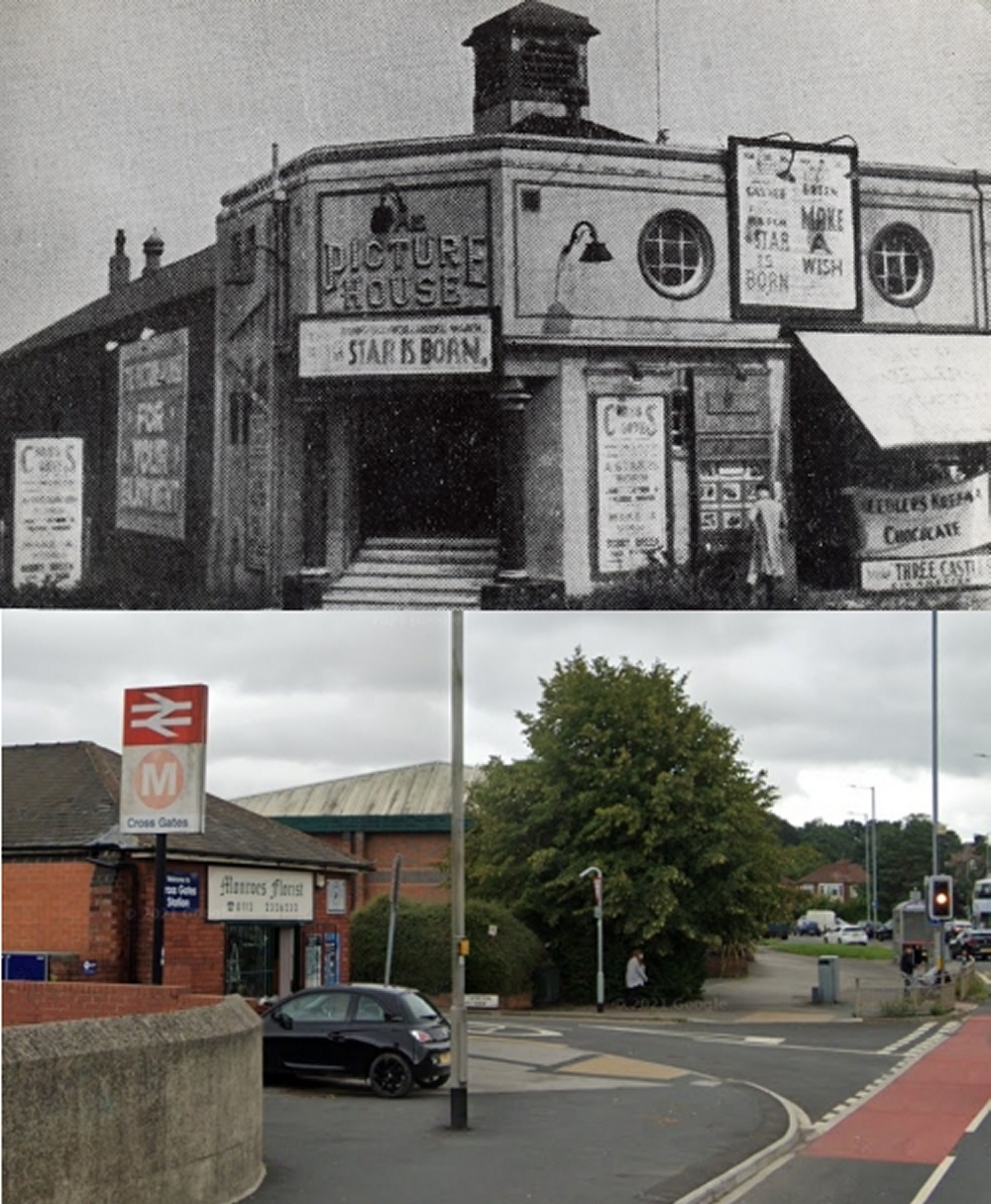 Cross Gates Picture House, Station Road, Cross Gates, c1937 & the location 2022. The Cross Gates Picture House, Leeds opened in 1920 and for nearly 45 years served the district with entertainment, films, escapism, news, and Hollywood glamour. It was located on Station Road adjacent to the south side of Cross Gates Railway Station in an area now containing retail units built in 1986. The story begins in the late 1910s when an enthusiastic group of businessmen saw an opportunity to bring films to the then rapidly developing suburbs of East Leeds. Leeds had cinemas since at least 1905 when the Coliseum on Cookridge Street (now the O2 Academy) built in 1885 as a concert hall and theatre was converted to show films, the Leeds Assembly Rooms on New Briggate (later the Plaza Cinema) were converted for films in 1907 and then between 1910 & 1916 over 50 cinemas opened either in purpose-built premises or converted buildings within the city boundaries. The media rapidly took over from the mainstay of entertainment of the day, the variety theatre. The land containing most of Cross Gates had been absorbed into the Leeds City boundaries in 1910 from Tadcaster Rural District Council and the city authorities made plans for large municipal housing schemes to compliments the construction of private housing which was already taking place in the district. The press referred to Cross Gates at the time as "the sleeping room" of Leeds with the easy commute to the City centre via the railway and, from 1924 a tram service. Seeing a gap in market, Richard Charles Oldham of the Old Hall, Scholes (located next door to the Barleycorn Inn, Scholes and demolished in 1973) a dramatic author, Owen Arthur Jepson of Ben Rhydding and Arthur Gawthorp Thomas of Knaresborough, both insurance brokers setup "The Cross Gates Picture House Limited" and became its first Directors. 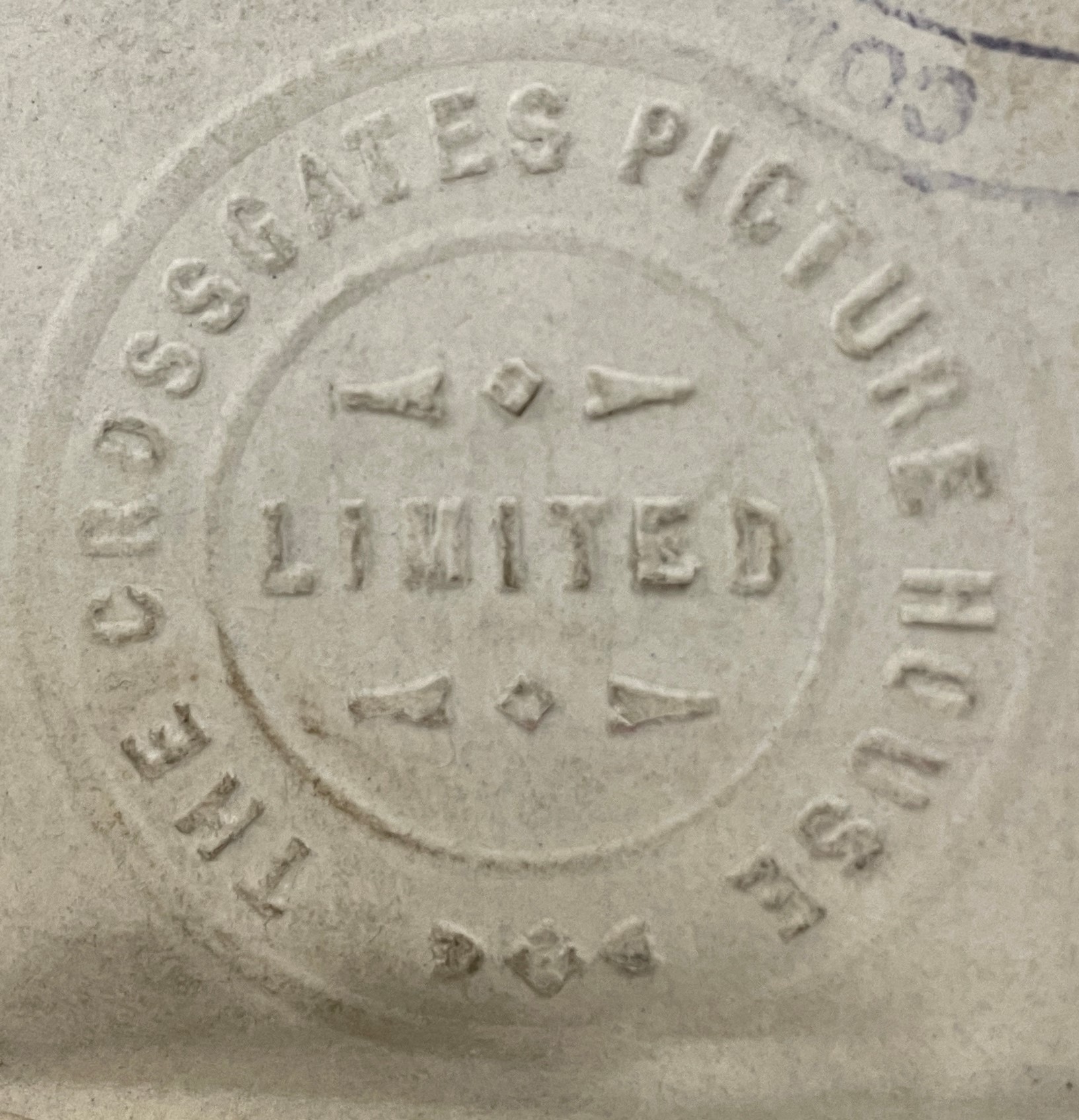 The Cross Gates Picture House Limited - Company Seal Richard C. Oldham was born in what is now Malaysia in 1872 to British parents, he had a talent for art and writing and became a scene painter for the Grand Theatre in Leeds. He was a member of Barwick Attic Abode Society, a group of bohemian artists, painters and writers who regularly stayed in a thatched cottage near the New Inn in Barwick-in-Elmet during the period 1900-1910. In 1913 his talent for writing was recognised by John Hart, the then Managing Director of the Grand and his pantomime "Goody Two Shoes" was the 1st of a series, written by him, put on by the theatre every year until 1930. He was called in his time "Yorkshire's uncrowned pantomine-writing king." 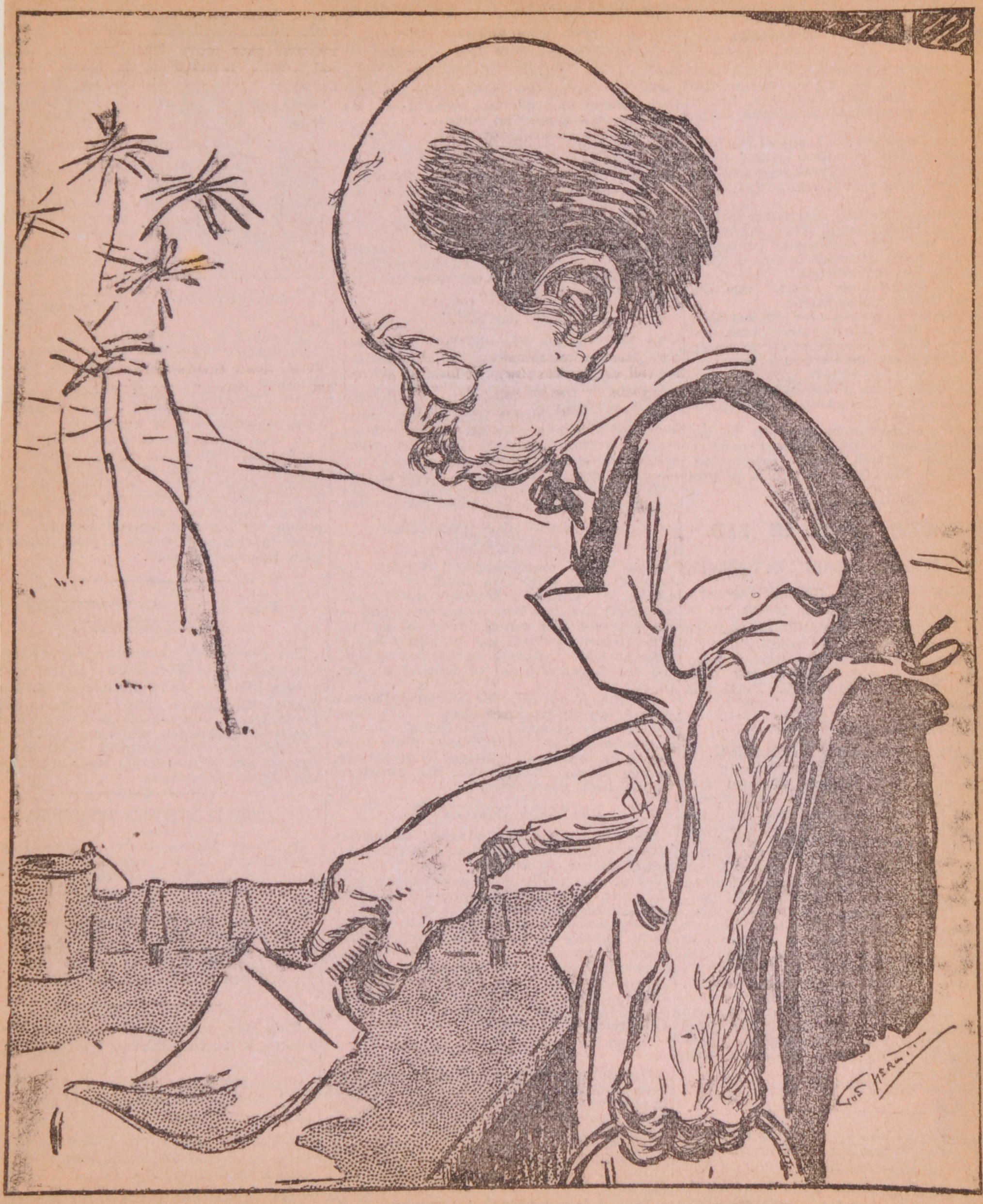 Cartoon of Richard Charles Oldham c1910 painting scenery at the Grand Theatre, Leeds The Directors of the Picture House located a suitable site containing 758 square yards of land adjacent to the Cross Gates railway station which was owned by the North Eastern Railway Company and arranged a 21 years lease at £100 per annum from the 4th July 1919. It is interesting to note that the plot of land was in the Parish of Austhorpe and just outside the Leeds City boundary at this time, this area was still the responsibility of Tadcaster Rural District Council (TRDC). 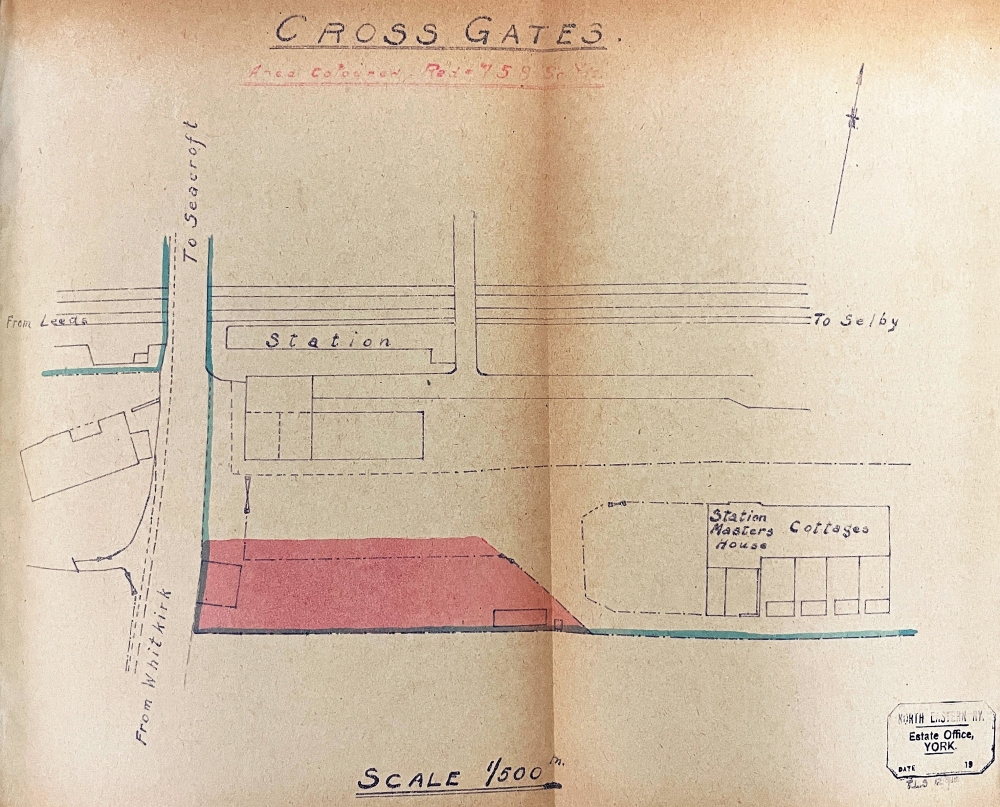 The land marked red leased by the Cross Gates Picture House Limited from the North Eastern Railway in 1919 John Place Crawford, an architect of Albion Street, Leeds was engaged to design the cinema. In his career he designed 14 Leeds cinemas including the Tower Picture House on New Briggate, the Shaftesbury on York Road and the Parkfield Picture Palace, Hunslet. For the Cross Gates Picture House he designed a rectangular hall with an art deco facade and entrance. The floor level of the western end of the building was raised by several steps and the eastern end slightly buried to allow a 1 in 10 slope in the auditorium and therefore a view of the screen from all seats. The seats on the back 19 rows were more spacious been 20 inches in width, the front 26 rows were only 18 inches. The house could seat 772. Lit by gas, as the district had no electricity at this time, a gas power room generated electricity for the projectors and fan extraction systems. An orchestra pit at the front allowed music to be added to then silent films produced by the studios. A lockup shop facing onto the road provided confectionaries. In the entrance vestibule was the pay-desk and toilets. One ladies WC was provided and one gents WC with an additional urinal for a cinema that could seat 772! Upstairs at the front was the office, projection and film rewinding rooms accessed by spiral staircase. The plans were approved by TRDC on the 30th June 1919. Now with a site and approved plan the Directors prepared a prospectus to raise the necessary fund to build the picture house through an issue of shares. This was published on the 20th November 1919 and printed in the local newspapers on the 28th and 29th November. A total of 10,000 £1 preference shares, payable in instalments, and offering an expected divident of 10% per annum, and 100,000 1-shilling ordinary shares were offered to give an authorised share capital of £15,000. 90,000 of the ordinary shares (value £4,500) were allocated to the Directors to purchase the Company from them which at the time consisted of the lease of the land and approved plans. It was estimated that taking a moderate average of seats occupied of half in the winter weeks and a third in the summer the picture house would make an annual profit of £2,030. Mr Ernest Rudland Wood, an Associate Member of the Institute of Electrical Engineers, but who appears to have no financial qualifications is quoted in the prospectus: "I have gone carefully into the prospective Earning Capacity and Expenses as shewn on attached statement, and, in the light of my experience of Picture and other Theatres and knowledge of the district, consider the profits as shewn are well within the figures they should attain." 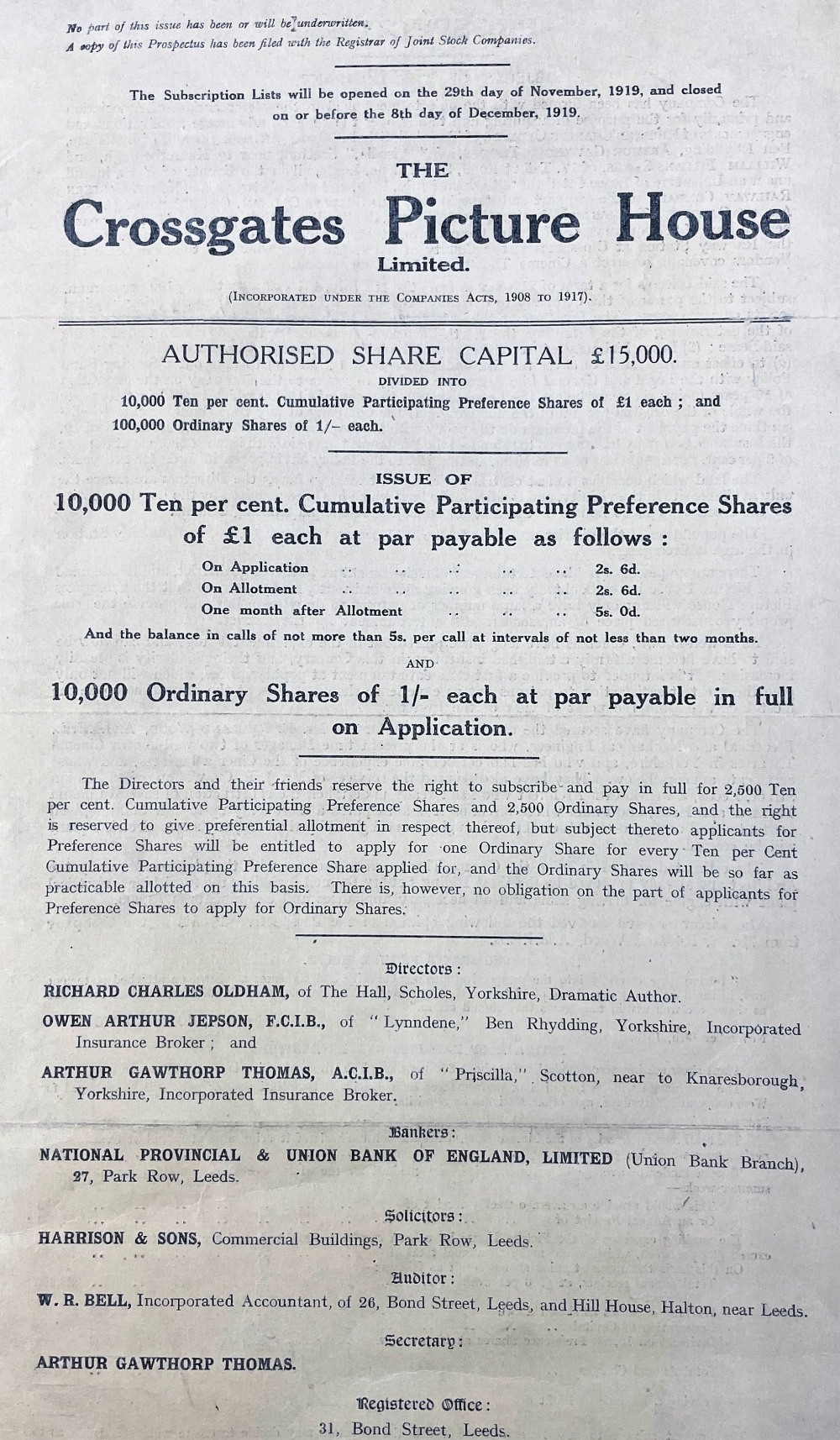 Cross Gates Picture House 1919 Share Propectus Title Page The share issue was reasonably successful with 7,742 of the 10,000 preference and 98,111 of the 100,000 ordinary shares allocated by the 25th February 1920 and 9,100 and 99,244 respectively by the 31st December 1920. The share register shows 130 individuals investing ranging from just 1 shilling to £1,000 although the majority invested less than £100. The building contract was let in December 1919 and construction started, by April 1920 the external walls and slated roof was completed and the internal fit out began. Costs were as follows: - Land and Buildings (including sale from Directors to Company of £4,500) £ 12,679 18 4 - Machines, Generators, etc £ 892 19 4 - Seating, Carpet, Furniture, Fittings and Sundry items £ 1,951 5 5 - Entertainment Stamps £ 18 11 7 - Expenses on forming the Company £ 812 2 A shortfall between the money raised and the initial construction expenses meant that a mortgage of £1,500 was taken out secured on the building in January 1921. 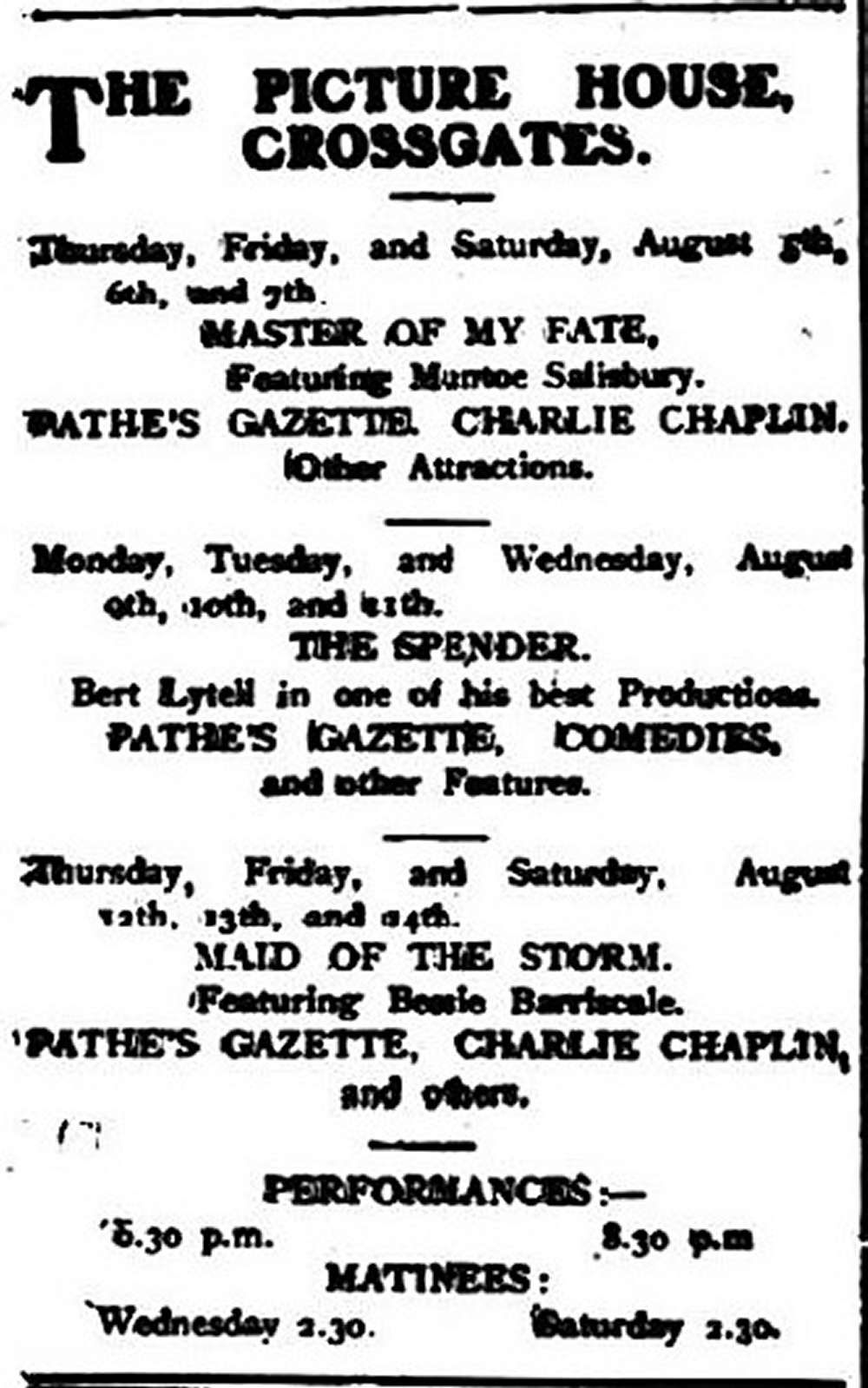 Cross Gates Picture House 1st Advert - Skyrack Newspaper A Captain Wright was appointment as manager, and it was scheduled to open on the 19th July 1920 but there were last minute delays and "THE NEW CROSS GATES PICTURE HOUSE" opened to the public on Saturday 31st July 1920. The local paper reporting: "The public comfort has been carefully studied and a better or more compact hall for the purpose it is built for could not be imagined, the management being well up to their duties in every respect. Patrons are highly satisfied with the luxuriance of the seating arrangements, and the artistic interior, which has a capacity for 800 people, The orchestral accompaniments are also of the very best, and the determination of the enterprising management is to complete in every respect with the programmes at the City picture houses."  There were teething trouble with the equipment and a complete breakdown on the first Monday open, the 2nd August 1920, resulted in all patrons having to leave, although they were given free tickets for another evening. Initially the Picture House had two shows each evening and matinees on Wednesdays (to capture the audience from the then local half day shop closing) and Saturdays, but by December 1920 what was known as continuous performances were adopted allowing people to please themselves as to the time they came in and bringing the cinema in line with the approach used in the rest of the Leeds cinemas. There was no Sunday film showings at this time, anywhere in the country.  The Cross Gates Picture House -c1925 - Hollyshaw Lane on the right In January 1921 the picture house manager, Captain Wright resigned, the local newspaper reporting "the regular patrons of the Crossgates Picture House will be extremely sorry that the genial and courteous manager, Captain Wright, is this week-end relinquishing an appointment he has held since the opening of the picture house, during which period he has given abundant evidence of exceptional managerial ability, with the result that he has made many friends at Crossgates, who will sincerely hope that in his new sphere he may have extended activity and prosperity" As a result of gas restrictions caused by a coal miners strike (after mine owners demanded wage cuts following the return of coal mines to private ownership on 31st March 1921 having been nationalised during World War I) from the 27th May 1921 until the 15th July 1921 there was only 1 film showing per evening, except on Saturdays. By December 1921 the picture house was also listed as the "Crossgates, Halton and Seacroft Picture House" now doubt to help increase footfall. A local interest film was shown on Monday to Wednesday 19th-21st December 1921 "Money" starring Henry Ainley a native of Morley who was stationed at Whinmoor during the then recent World War I. 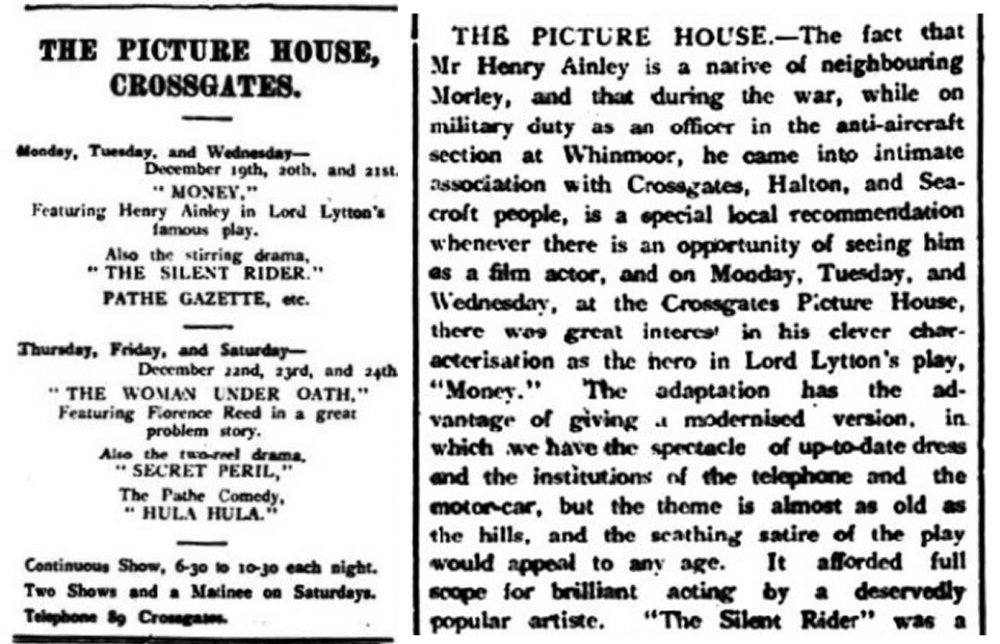 Skyrack Newspaper - December 1921 The district saw it‘s first Charlie Chaplin and Buster Keaton comedies during the 1920s in the golden age of the silent films. Football cames to the cinema in March 1924 when the Yorkshire Evening Post sponsored a film. 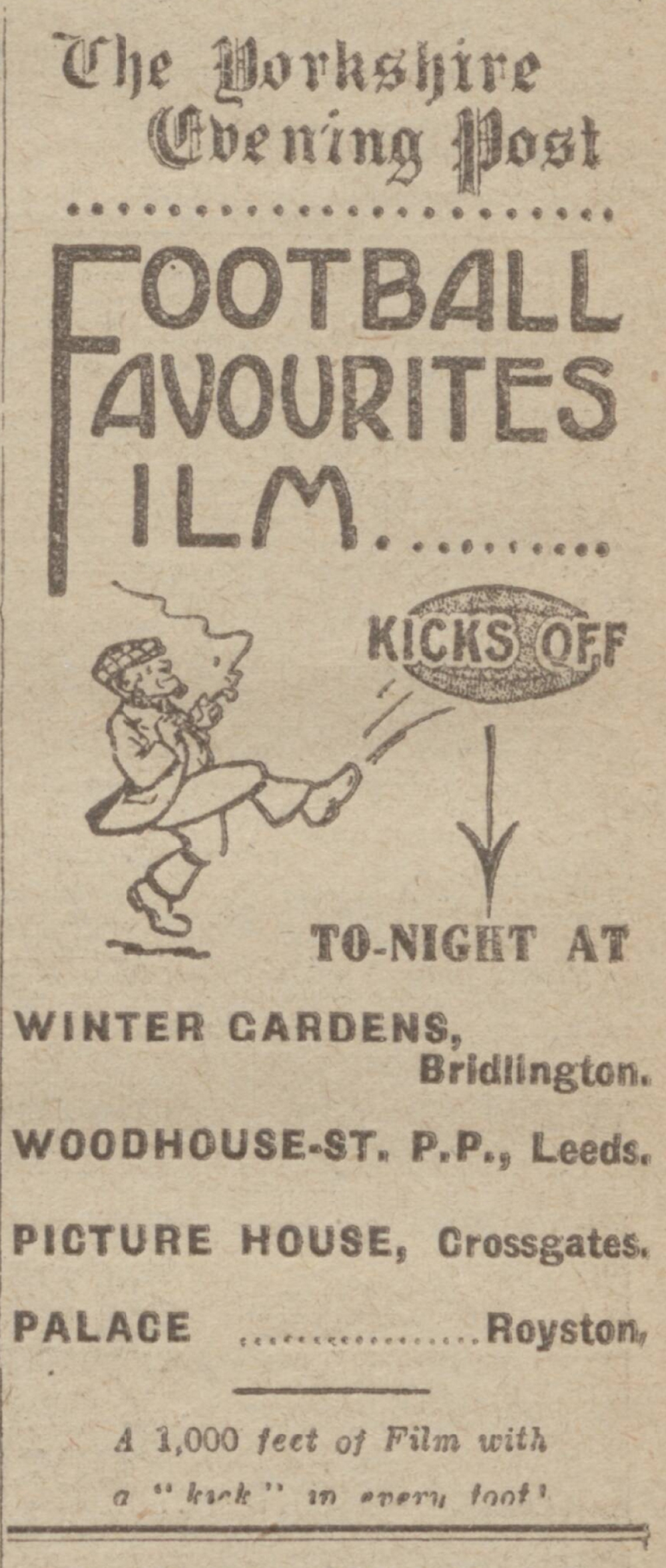 12th March 1924 - Football comes to the screen, a kick in every foot of film! Leeds City local government boundaries were extended on the 1st April 1928 under the Leeds Corporation Act 1927 and Picture House then moved into the jurisdiction of the Leeds City licensing area. In May 1928 the Corporation approved Mr. Arthur Rudland Wood be granted a license for music and cinematograph at the Cross Gates Picture House. Arthur Wood was the son of E. Rudland Wood, the Electrical Engineer, who was quoted in the prospectus of 1919. It is likely he had been manager for some time prior to this as the cinema licensing records prior to 1928 have not been discovered. During the Summer of 1928 the floor was re-laid and the seating replaced. In October a new fire exit was provided on the north side of the auditorium, no doubt relating the strengthening of fire regulations. In April 1929 James Hugh Grant took over as manager and the cinema started to be managed by Counties Cinema Circuit Ltd. There were a number of cinema circuits in the country and it was a common approach to the management of cinemas at the time. Sometimes they purchased or leased cinemas but in the case of the Cross Gates Picture House the Directors obviously thought it was better to allow the circuit to run the business and deal with management of the premises and film bookings, allowing better volume deals to be struck with distributors and suppliers. In the case of the Picture House the Directors and Limited company retained ownership of the building. Mr. Edwin Adeler took over as manager in May 1929. 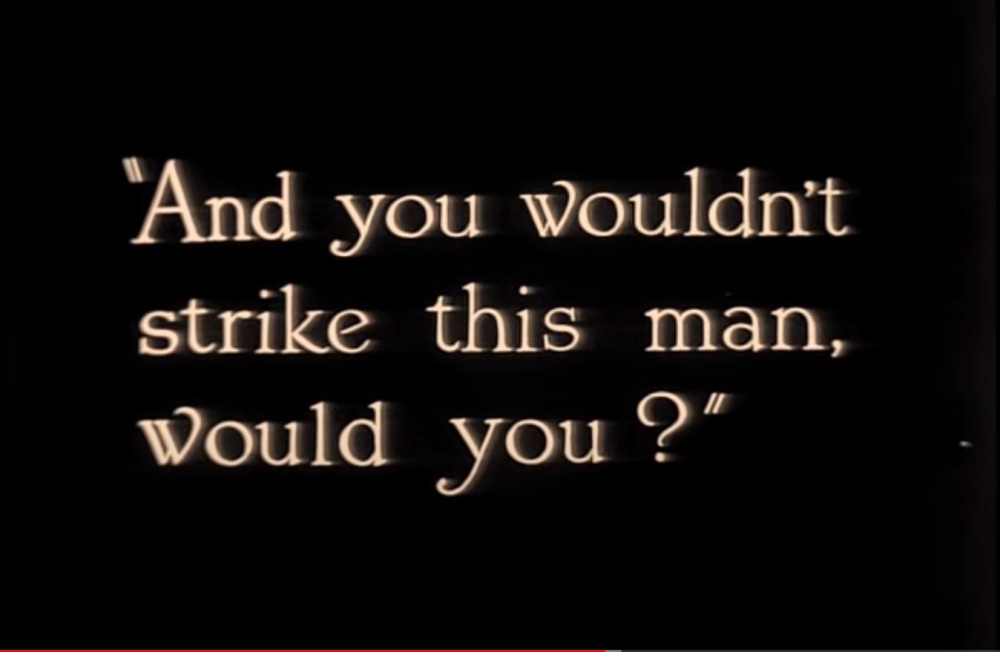 Intertitle used in Silent Films - From Charlie Chaplins - The Kid - shown at the Picture House Monday-Wednesday 6th - 8th February 1922 The late 1920s was a period of massive change in the film industry, the TALKIES had arrived! For most of the 1920s the cinema had shown silent films, likely with several musicians or piano accompaniment and text inter-titles to narrate story points. The development of sound recording technology coupled with reliable film synchronization allowed short sound films to be produced from the mid 1920s and then in 1927 the 1st feature length movie with recorded sound, Al Jolson in "The Jazz Singer" was released. Sound films rapidly became a global phenomenon! There was considerable expense required to convert a cinema to show sound films and this may have been behind the decision to move onto the Counties Cinema Circuit. During early September 1929 the necessary alterations were made and on the 9th September sound films came to Cross Gates with "The Donovan Affair" an American comical murder-mystery film produced by Columbia Pictures. There were a number of sound systems available and the Picture House was fitted with British Talking Pictures Ltd equipment. 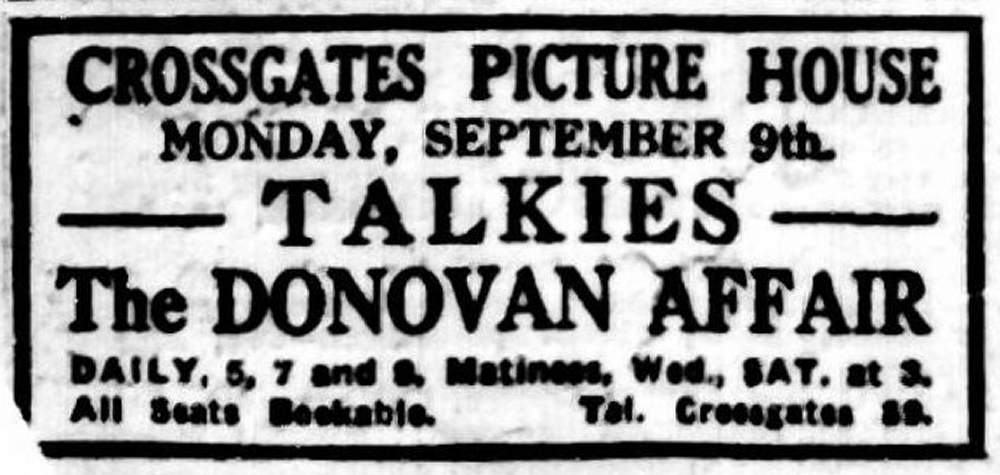 1st Talkies Advert for the Picture House - Yorkshire Evening Post 5th September 1929 The Yorkshire Evening Post newspaper reported on the 7th September 1929: "Talkies in The Bedroom of Leeds" Since the Crossgates Picture House came under the control of Counties Cinema Circuit Ltd, the cosy little theatre has been brought "bang up to day" as the saying goes. The new proprietors, who also control the Pavilion, Wombwell, and the Empire, Normanton, have installed new Kalee projectors with Ron's Lenses, and instituted an elaborate scheme of re-decoration. The house has been re-wired and fitted for talking pictures, and the bookings include "The Singing Fool", "Show Boat", "The Broadway Melody", "The Trial of Mary Dugan", "The Doctor’s Secret", "On Trial", "Interference", "Blackmail", "Broadway" and all the best films, in the order of their release. The company now claim that they are able to offer the public of "the bedroom of Leeds" precisely the same entertainment as is given at the leading cinemas in the West End of London. Considering that the Crossgates cinema has a capacity of 600, with prices ranging from 1s 6d to 6d., the new controllers are "out" to keep Crossgates fold "in" when it comes to entertaining them. 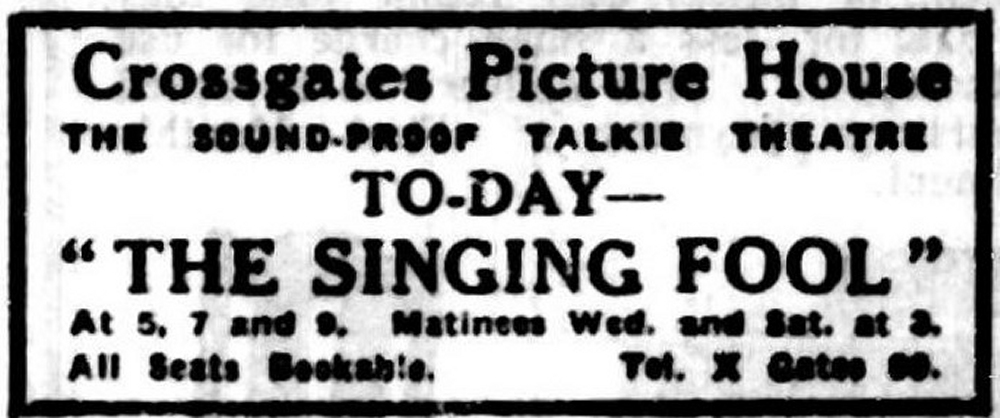 The Sound Proof Talking Theatre - Advert for the Picture House - Yorkshire Evening Post 16th September 1929 Fire in cinemas had been a constant worry for the authorities as most of the film used until the 1950s was nitrate based and highly combustible. Many of the earliest cinema regulations relate to fire safety. A cinema tragedy on New Years Eve 1929 in Paisley, Scotland focused minds further on safety. 71 children were crushed to death trying to leave a cinema when smoke was reported to have been seen and someone shouted "fire". The exits were locked and doors opened inwards. 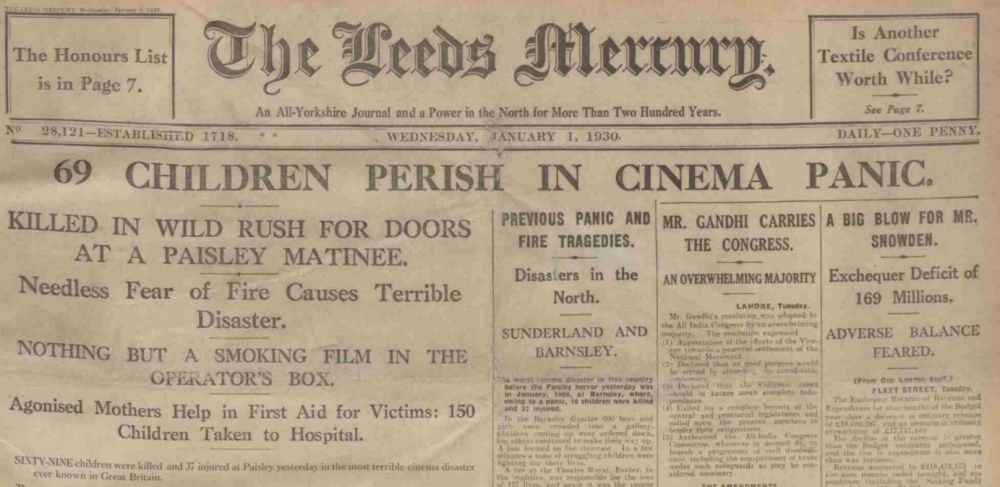 Glen Cinema disaster, 71 children crushed to death in Paisley, Scotland Cinema fire and exit regulations were improved and push-bar outward opening doors mandated. A fire drill was completed at the Picture House at a childrens matinee in January 1930 when 300 children managed to leave in 90 seconds, and at an evening performance 600 adults took 120 seconds. Mr. B. Pass was manager from February to May 1930. Around 1932 W. Owen Brooks became the Picture House manager, he was an interesting Leeds cinema pioneer, originally a studio portrait photographer in Dewsbury Road, Leeds, he knew Frieze-Green and also Augustin Le Prince, who invented the first cine apparatus in a Woodhouse Lane workshop, making a brief silent film on the 14th October 1888, now called ""Roundhay Garden Scene" and believed to be the oldest surviving film in existence and a few days later a film on Leeds Bridge and he disappeared mysteriously in France in 1890. Owen himself made his own camera and filmed in 1900 from a horse drawn tram running along Boar Lane. He was also a motorcycle enthusiast building his own machine and obtained the 1st Leeds registration number "U1". 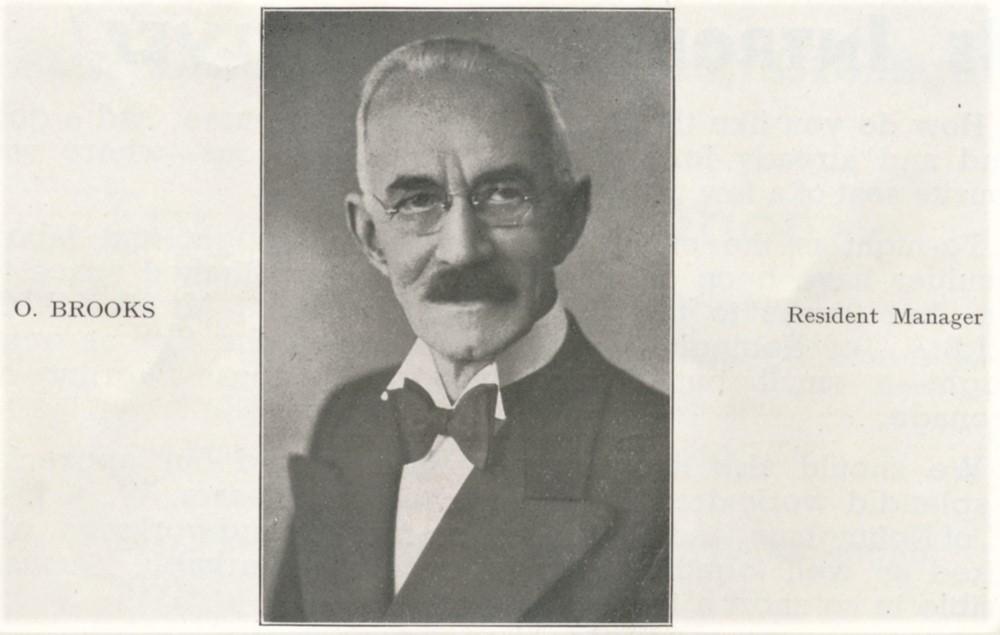 W. Owen Brooks - Manager of the Picture House from c1932 More housing continued to be built in the district during the 1930s and it was likely a golden time for the cinema with most families having a weekly visit to the flicks. 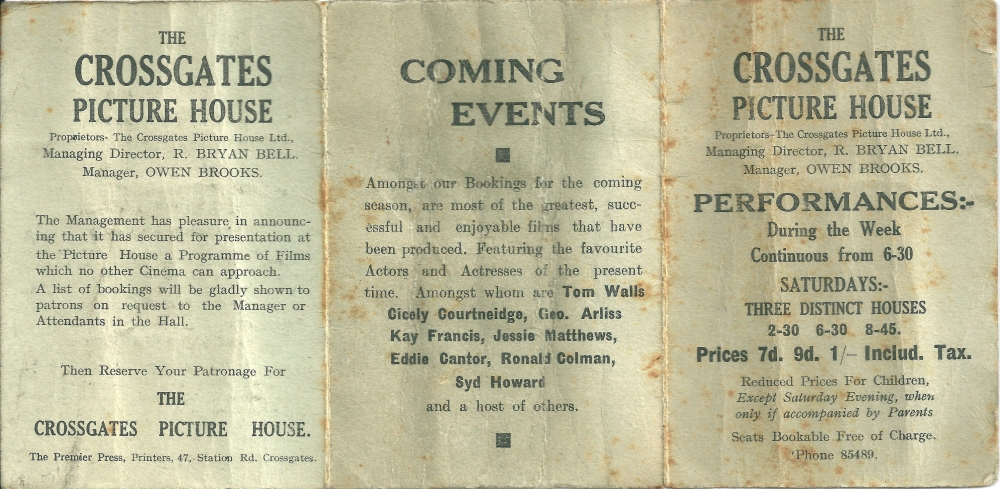
 Advertising Card from April 1934 In early 1936 news reached the Directors that a new "Super Cinema" was to be constructed just a 1/3 of mile away at the junction of Cross Gates Road and Lane. The Regal Cinema opened on the 16th November 1936 with seating for 1,500. The Cross Gates Picture House responded to the anticipated competition in September 1936 by alterering the seating to provide different levels of comfort and space and is so doing reduced the capacity to 475. 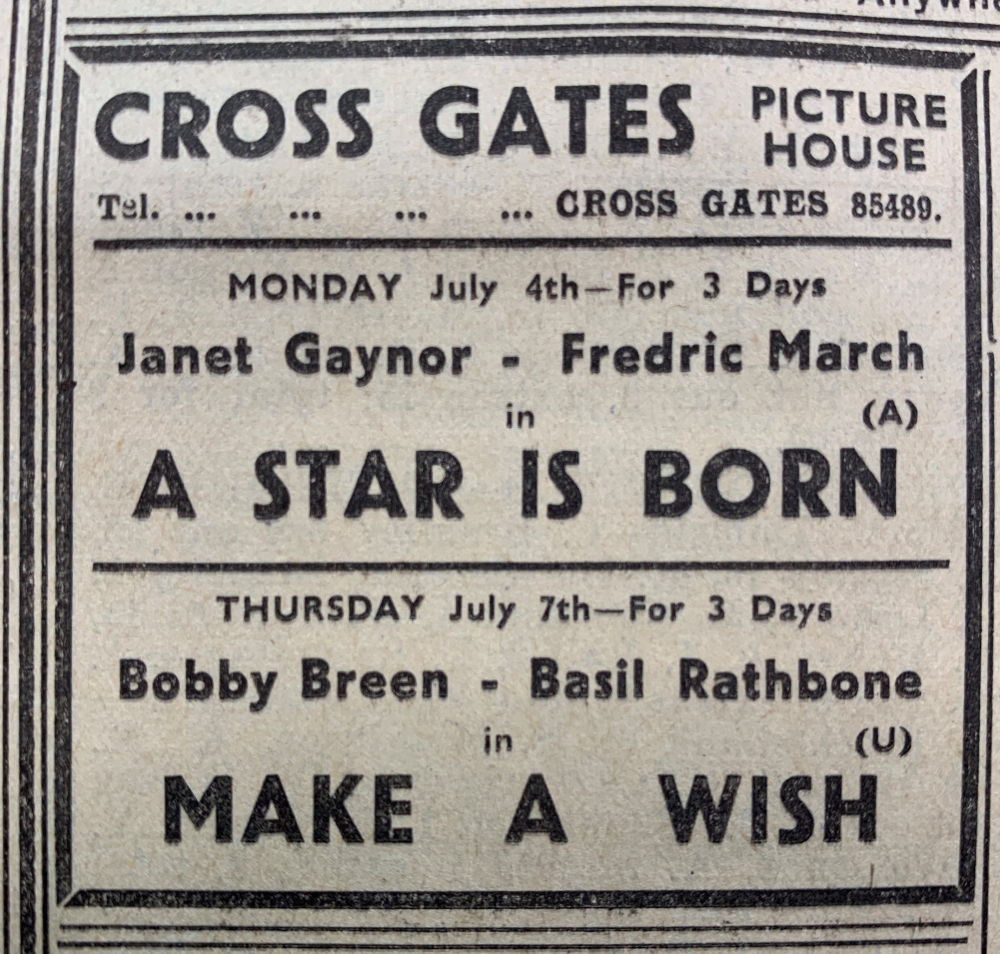 Skyrack Newspaper - July 1938 - Picture House Advert Whilst no detailed day to day company accounts have been found the opening of the Regal must have hit the Picture House hard. In the summer of 1938 eighteen months after the competition opened the lease of the land from the NER on which the cinema was constructed (now merged with a number of other railway companys and called the London and North Eastern Railway (LNER)) had less than 2 years left to run and the cinema was old fashioned, in need to refurbishment and likely a dwindling numbers of patrons. The Directors decided to maximise their return and sell up. They negotiated with the LNER and it was agreed that the site could be purchased freehold for £2,000. And so, into the frame came, again, Ernest Rudland Wood and his son Arthur Rudland Wood with their company Rushford Estate Ltd (likely named after Ernest's wife's maiden name), he agreed to purchase the cinema business and site for £4,750. The Cross Gates Picture House Limited was put into voluntary liquidation. It was a sad end for the band of enthusiastic businessmen and supporters who had set it up nearly 20 years before. After repayments of debts and mortgages the ordinary shareholders received no pay out and the preference shareholders, who had originally paid £1 per share, received a payment of 7 shillings in the £1. The expected 10% annual dividend on the preference shares appears to have never been paid with a final unpaid arrears of £16,519 to the 2nd July 1938. 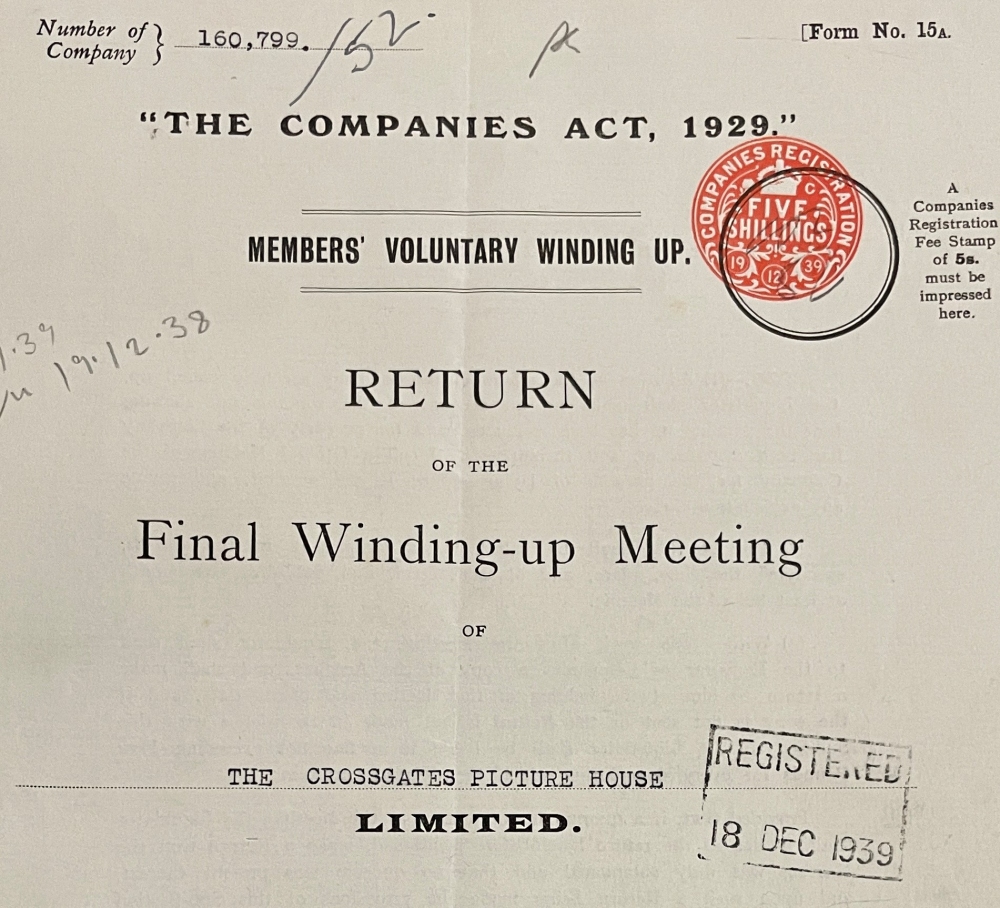 Cross Gates Picture House Company - Final Winding Up 1939 Rushford Estate Ltd and the Woods then embarked on a major refurbishment of the cinema detailed on the next page. Reborn : The Ritz Cinema 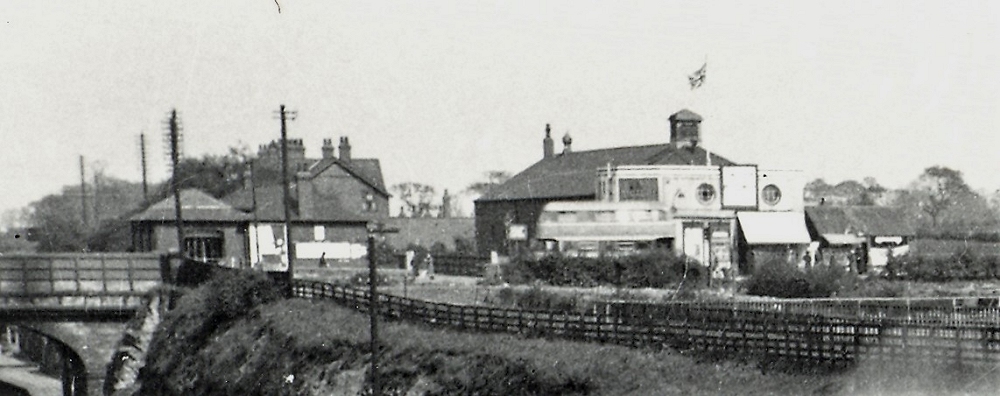 Cross Gates Railway Station and Picture House (with Union Jack flying) c1935 Dave Teal April 2022 Reborn : The Ritz Cinema Back to the top Back to the Main Historical Society page Back to the Barwicker Contents page |